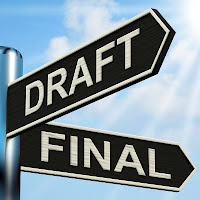Scene Blocking: What It Is, Why Do It, and How
 |
| Image courtesy of Stuart Miles Freedigitalphotos.net |
Odds are, the scene is incorrectly or poorly blocked.
What Is Scene Blocking?
Scene blocking looks at the geographical space in the story, identifying where the characters, objects, and events occur. The author needs to take the time to determine the layout. In some cases, authors sketch it to see how everything interacts. One of my favorite authors, C E Murphy, checks her blocking by role playing her fight scenes with her husband. That's got to be fun!Why Should You Check Your Scene Blocking?
Some of the issues I've observed while critiquing others' work include a weapon in a character's hand that still holds a horse's reins or grips an elbow in pain. They never put down the reins or released their elbow. Maybe someone is punching a person who is behind them, not in front...or worse yet, nowhere within arm's reach.If something occurs in your story that is physically impossible for the characters, then it bothers your reader. They can't follow the action because they're unsure of the environment and setting.
How Can You Identify Scene Blocking Issues?
Some questions you should ask include:- Where is this character?
- What direction is the character facing? What can they see?
- Is the character holding something? In which hand?
- What objects are in this space?
- Where are the objects in relation to the character?
- What other characters are in the scene?
- Where are these characters in relation to the first character and the objects?
What's the Best Blocking Advice I've Received?
When I needed to write a large battle scene in my fantasy series, I struggled for a long time. I couldn't get it started. For weeks, I danced around the issue, writing everything BUT the battle. Then I spoke to Faith Hunter, another one of my favorite authors, and she gave me great advice.
I won't go into the full description here, but the idea was to get large pieces of construction paper, colored pens, and colored sticky notes, and lay out the battle. This helped me visualize the battleground in a way I had not been able to before.
Then on a second piece of paper, I created a mindmap indicating the sequence of events and how everything played out together.
This process helped me determine how many troops each army brought to the field. It helped me visualize the individual scenes within the overall battle. Most importantly, I was able to create a believable outcome. It worked, and, with these visuals in front of me, I wrote the battle. (The photo is my layout of the battle ground.)
That's scene blocking. Do you need it for every scene? Maybe not to the arts and crafts extent, but you should always be aware of scene blocking while editing and revising your work.



Comments